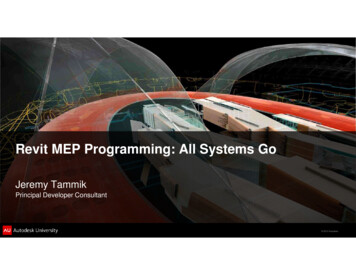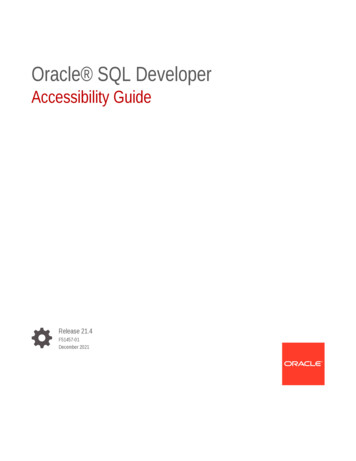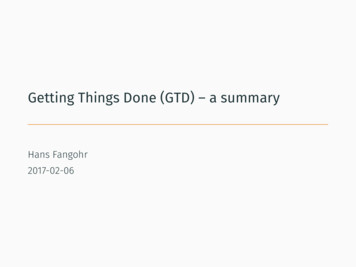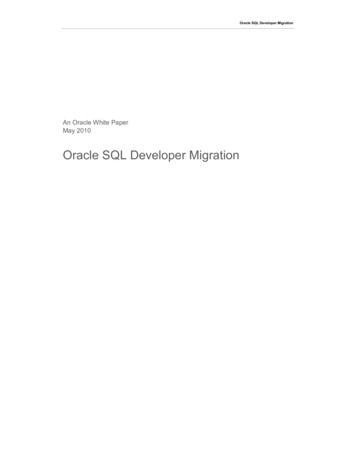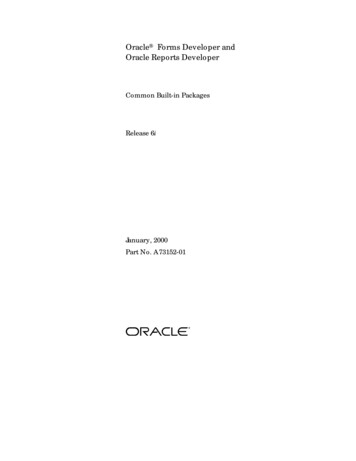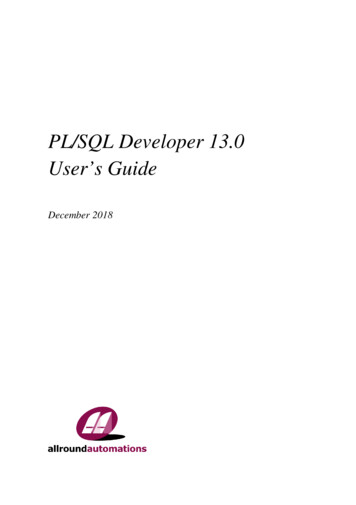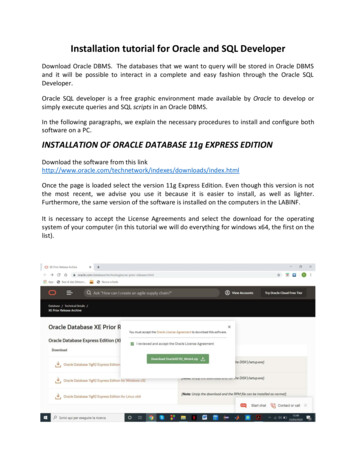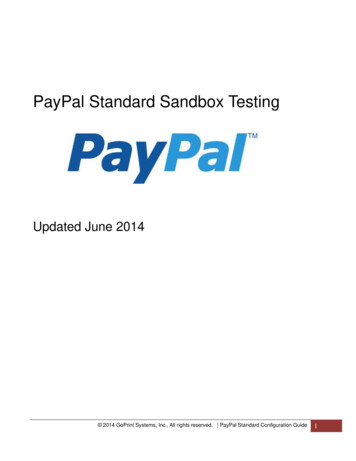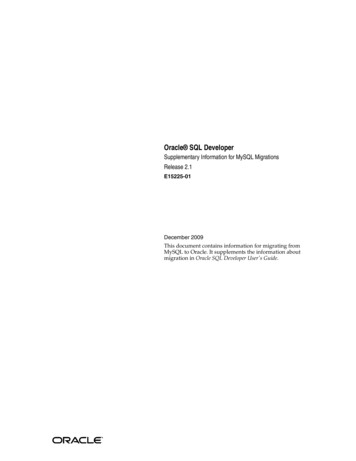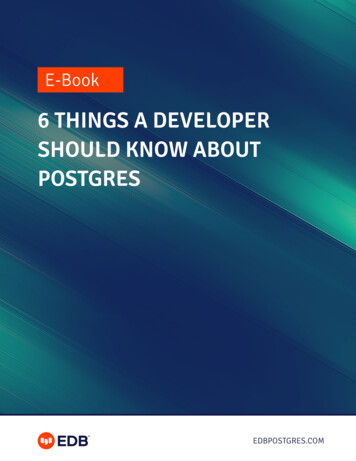
Transcription
E-Book6 THINGS A DEVELOPERSHOULD KNOW ABOUTPOSTGRESEDBPOSTGRES.COM
6 THINGS A DEVELOPER SHOULD KNOW ABOUT POSTGRESContents1. Introduction03Many enterprises are choosing PostgreSQL because it offers performance,scalability and reliability that is comparable to enterprise databases like Oracle.2. No Need to Learn a New IDE 04Here are some tips to make cloud deployment more cost-effective andoptimized, so you can get more out of it.3. Simple Local Setup and Configuration 05Tools from EDB can automate patching, backups, provisioning, scaling,failover and upgrading, alongside many other important management tasks.4. Flexible Multi-Model Architecture 06Today, more DevOps teams are leveraging the power of containerizationand container orchestration technologies like Kubernetes to create anddeploy cloud native applications.5. Agile and DevOps Friendly 08It can be difficult to let go of mission critical processes, but savvycompanies in many industries are finding new leverage in the practice.6. Cool Things You Can Do With PostgreSQL 09It can be difficult to let go of mission critical processes, but savvy companiesin many industries are finding new leverage in the practice.7. Smooth Road to Production 12It can be difficult to let go of mission critical processes, but savvy companiesin many industries are finding new leverage in the practice.8. Final Note 13EDB WWW.EDBPOSTGRES.COM01
6 THINGS A DEVELOPER SHOULD KNOW ABOUT POSTGRES1INTRODUCTIONFor a long time now, PostgreSQL has been one of the most frequentlydeployed relational database management systems. Over the past fewyears, however, it has seen a sharp rise in popularity with developers.According to DB-Engines, PostgreSQL (or Postgres) was ranked thefourth most popular database management system in April 2019, asscored by search engine results, technical discussions, social andprofessional network mentions, and job offers:We also learn from the 2018 Stack Overflowsurvey of more than 100,000 developers thatPostgreSQL ranked as the third most useddatabase technology:MySQLSQL Server58.7%PostgreSQLMongoDBSQLiteEDB WWW.EDBPOSTGRES.COM25.9%19.7%41.2%32.9%02
6 THINGS A DEVELOPER SHOULD KNOW ABOUT POSTGRESIn short, Postgres has come a long way since its origins as a research project in the mid-1980s at the Universityof California, Berkeley. Its first step towards the mainstream was in 1995 when it replaced its query language(PostQUEL) with SQL, the de facto industry standard. The very next year, PostgreSQL left academia with theestablishment of the PostgreSQL Global Development Group, which took the open-source Postgres codebase underits wings. Since the release in December 2014 of PostgreSQL 9.4 (the oldest of the versions currently supported),its popularity has risen steadily, as shown by DB-Engines historical graph:DB-Engines ranking of PostgreSQLScore (logarithmic greSQLThere are a number of factors that have contributedRDBMS. It is also highly flexible, supportingto PostgreSQL’s popularity, not the least of whichrelational and non-relational models in the sameis its highly active open-source community that,DB, and can be deployed across a wide range ofunlike a company-led open source DBMS likeinfrastructures from bare metal to VMs, containers,MongoDB or MySQL, is not controlled by any singleand DBaaS.sponsor or company. Its feature set is continuallybeing extended, with the community testing eachIn this tech guide, we describe six things that anew feature thoroughly before integration, so thatdeveloper should know about in terms of how easythe highest level of reliability is upheld. Despiteit is to install, work with, and deploy Postgres asits wealth of features, Postgres is lightweight (thewell as the unique capabilities and wide range ofsource code is less than 20 MB), easy to install, andfeatures that Postgres offers.easy to move around compared to bulky proprietaryEDB WWW.EDBPOSTGRES.COM03
6 THINGS A DEVELOPER SHOULD KNOW ABOUT POSTGRES2No Need to Learn aNew IDE.it is unlikely thatyou will need toinstall and learn anew IDE, becausechances are that theframework you areused to working withis already integratedwith PostgreSQL.When you opt for a proprietary DBMS, you prettymuch have to buy into their development andadministrative tooling as well. If you choose towork with PostgreSQL, however, it is unlikelythat you will need to install and learn a new IDE,because chances are that the framework you areused to working with is already integrated withPostgreSQL.The Community Guide to PostgreSQL GUI Tools onWiki currently lists no less than 18 freeware and63 proprietary IDEs that support PostgreSQL,including: pgAdmin, a GUI maintained by members ofthe PostgreSQL community for developing andinterface for creating, developing, and executingadministering PostgreSQL databases on Linux,queries, editing and adjusting code, importing andUnix, Mac OS X, and Windows.exporting data, reporting and editing data, andmore.TOra, a free Oracle DBA interface with somePostgreSQL support. dbForge Studio for Postgres, a user-friendly and text tools to build queries, a visual databaseDBeaver, a multi-platform database tool thatdesigner, rapid database management, navigationsupports the most popular SQL and NoSQLand maintenance, and more.databases, including Postgres. (Its CommunityEdition is free, while its Enterprise Edition issubject to a license fee.)EMS SQL Manager for PostgreSQL, with visual JetBrains’ DataGrip, a multi-engine database IDEfor writing SQL code, exploring databases, runningqueries, importing/exporting data, and more.EDB WWW.EDBPOSTGRES.COM04
6 THINGS A DEVELOPER SHOULD KNOW ABOUT POSTGRES3Simple Local Setup and ConfigurationMany traditional RDBMS interact in proprietary wayswith storage and operating systems. For example, theyrequire special kernels or raw devices, they use lowlevel operating system functionality, their backup toolsand appliances are highly invasive, and so on. As aresult, setting up the local environment and configuringproprietary database management systems are complexand timeconsuming tasks that must be carried out byspecialized and experienced DBAs before developers canget started on the project at hand.By contrast, one of the design principles of PostgreSQLfrom the very start was that it would interact seamlesslyand predictably with operating systems and storageframeworks. It is remarkably easy to install, set up, andconfigure a PostgreSQL deployment. In fact, developerscan handle simpler deployments themselves, with DBAsonly needing to get involved in larger-scale productiondeployments. PostgreSQL also integrates easily withstandard operating system backup and monitoringtooling. It is lightweight and easy to move around, andsurprises are rare. For all these reasons, PostgreSQL is agreat enabler for developers across the entire applicationlifecycle—from prototyping to production.Service (DBaaS) model, including Amazon RDS for PostgreSQL, Azure Database for PostgreSQL, and (Google)Cloud SQL for PostgreSQL. There are also third-party vendors that offer fully managed PostgreSQL cloud services,including our own EDB Postgres Cloud Database Service on the AWS cloud.EDB WWW.EDBPOSTGRES.COM05
6 THINGS A DEVELOPER SHOULD KNOW ABOUT POSTGRES4Flexible Multi-Model ArchitectureThe Postgres research project that ultimately spawnedPostgreSQL was a pioneer of the objectrelational DBMS(ORDBMS), i.e., a relational database that is extendedto support some objectoriented programming features.These include extensibility of data types, accessmethods and functions, inheritance of table propertiesand data types, polymorphism (with an operator havingdifferent meanings within the same database), andencapsulation of tables. When storing and retrievingdata in an ORDBMS, an object-relational mapping (ORM)tool automatically translates between non-scalar objectvalues (attributes and fields) and scalar relationalThe Postgres researchproject that ultimatelyspawned PostgreSQLwas a pioneer of theobjectrelational DBMS(ORDBMS).values (integers and strings organized within tables).Today, all of the leading ORM tools support PostgreSQL.EDB WWW.EDBPOSTGRES.COM06
6 THINGS A DEVELOPER SHOULD KNOW ABOUT POSTGRESThe multi-model ORDBMS approach is important fortoday’s advanced apps that typically have to queryand manipulate both structured and semistructureddata, which can require implementing both SQL andNoSQL databases in a single application. PostgreSQL,for example, has built-in support for storing JSONobjects in a compact JSON binary format. This feature isespecially convenient for applications that pass aroundsemi-structured documents in JSON format and wantto store them directly in the database in order to ensurehigh fidelity. This semi-structured data can be storedand queried alongside more structured data in tables aswell, and all of it can be accessed using standard SQLand tooling.In short, the power of the PostgreSQL multimodelarchitecture is that you do not have to embrace anew development and administrative tool chain toget the benefits of an ORDBMS– such as accelerateddevelopment cycles and enhanced runtimeperformance.EDB WWW.EDBPOSTGRES.COM07
6 THINGS A DEVELOPER SHOULD KNOW ABOUT POSTGRES5Agile and DevOps FriendlyPerhaps one of the biggest attractions of PostgreSQL for developers is that it lends itself well to dynamic DevOpsenvironments and requirements.First of all, getting started with PostgreSQL is frictionless. There are no lengthy procurement cycles, since thelicense for any kind of use, including commercial, is free and permissive. As already discussed above, setting up andconfiguring the PostgreSQL environment is straightforward. Plus, the fact that PostgreSQL is readily available as acloud service aligns well with the cloud-based nature of DevOps methods.Secondly, PostgreSQL’s multi-model architecture and its support for JSON and ORM mean that systems canbe quickly prototyped without the need to fully design a detailed schema. In general, PostgreSQL fits well intocontinuous development, integration, and deployment processes, because it is easy to make and test small updatesfrequently. Developers can ensure consistent infrastructure configurations across the entire application lifecycleby introducing Infrastructure-as-Code recipes using Chef, Ansible, Puppet, or any other infrastructure automationplatform. And PostgreSQL also fully supports the use of containers and microservices that are at the heart oftoday’s modular, distributed app architectures.Last but not least, PostgreSQL is highly portable, making it extremely easy to replicate instances for development,testing, and staging purposes. In PostgreSQL, there are clear boundaries between the database and underlyingoperating and storage systems. This is unlike traditional database management systems, such as DB2 and SQLServer that are inextricably tied into the DBMS owner’s operating system. Thus, it is easy to move PostgreSQLdatabases around, run them locally or in the cloud, or run multiple versions that do not interfere with each other.Whatever you can do in your standard operating system or storage framework (copy directory, change permissions,etc.) you can do seamlessly in PostgreSQL. With everything, including data storage, installed in one directory andvirtually no hooks to external resources, all you have to do is copy the file system in order to copy the database.EDB WWW.EDBPOSTGRES.COM08
6 THINGS A DEVELOPER SHOULD KNOW ABOUT POSTGRES6Cool Things You Can Do With PostgreSQLBefore we get to the really cool stuff, we would like to point out that PostgreSQL is highly ANSI SQLcompliant. Thus,developers who already have SQL skills will feel right at home in PostgreSQL. Those who are new to SQL can takecomfort in the fact that SQL is (relatively) easy to learn and that there’s a lot of PostgreSQL tooling for buildingand testing SQL. EDB’s Postgres Enterprise Manager (PEM), for example, extends the community’s administrationand management tool (pgAdmin) to meet the needs of large-scale enterprise PostgreSQL deployments, includinga powerful SQL editor and query builder. The really cool stuff starts, however, with the fact that, as discussedin the section on its multi-model architecture, PostgreSQL has built-in support for many non-relational NoSQLfeatures without the drawbacks of NoSQL (such as client-side data analysis, lack of a powerful query language andoptimizer, and data retention becoming an admin responsibility):EDB WWW.EDBPOSTGRES.COM09
6 THINGS A DEVELOPER SHOULD KNOW ABOUT POSTGRES Arrays: A table column can be defined as a Geometric Support: Data types for representing two-multidimensional array of any built-in or userdefineddimensional spatial objects as well as a set of functionsbase type, enum type, or composite type.vand operators to perform geometric operations such as scaling, translation, rotation, and determiningTJSON/JSONB data type: This validates storedvalues against the JSON rules, with built-inintersections.JSONspecific functions and operators available. JSONstores an exact copy of the input text, while JSONB decomposes the input text into a binary format that isfor well-formedness and provides functions to performfaster to process and supports indexing.type-safe operations. Character Strings: PostgreSQL has all the supportXML Support: The xml data type checks input valuesMany Specialized Index Types: In addition to thethat you would expect for storing, manipulating, andGiST and GIN indexing infrastructures alreadyquerying character strings. More advanced capabilitiesmentioned in the context of full-text search,are available through extensions, such as full-textPostgreSQL supports:indexing using ZomboDB, an Elasticsearch PostgreSQLextension. B-Tree: Used for most data types and queries, canalso be helpful in retrieving data in sorted order, and Full-Text Search: This feature is fast and optimized,supports multicolumn indexes.with support for fuzzy matching, ranking, phrasesearch, and multiple languages. It also supports GiST and GIN index types to speed up full-text searches.datasets with natural but uneven clustering. Range Types: Built-in range types include integer,bigint, numeric, timestamp (with and without timeSP-GiST: Space-partitioned GiST, used for largerBRIN: “Block Range Index,” a form of indexing forlarge datasets that line up sequentially.zone), and date. PostgreSQL also lets you definecustom range types.EDB WWW.EDBPOSTGRES.COM10
6 THINGS A DEVELOPER SHOULD KNOW ABOUT POSTGRESThere are also numerous third-party plugins—PostgreSQL is a highly communicative and versatilemany of them open source—that extend PostgresDBMS that uses Foreign Data Wrappers (FDW) tocapabilities. These extensions are so tightlyseamlessly read from and write to foreign dataintegrated that they behave the same way as built-sources. Some notable FDWs include CouchDB,in features. Some good open source examples are:Informix, MongoDB, MySQL, Neo4j, Oracle, andTimescaleDB and PipelineDB, for time-series dataRedis. You can see a long list of currently availableaggregation and graphs; AgensGraph, a transactionalFDWs in the Postgres Wiki (although not all of themgraph database; and PostGIS, which adds supportare officially supported by the PostgreSQL Globalfor geographic objects and location queries, turningDevelopment Group). With FDWs, you can use aPostgreSQL into a fast, robust, and feature-richsingle PostgreSQL database to federate at scale aspatial database management system.diverse range of data sources and formats as well asapp requirements, as illustrated below:EDB WWW.EDBPOSTGRES.COM11
6 THINGS A DEVELOPER SHOULD KNOW ABOUT POSTGRES7Smooth Road To ProductionPostgreSQL’s flexibility and ease of use also apply to how it is deployed in production. PostgreSQL lives comfortablyon all of today’s popular deployment platforms, from bare metal to VMs (on-prem or IaaS), containers, andDBaaS. The right choice of platform will depend on many factors, including the app’s scalability and availabilityrequirements, its architecture, and the extent to which the organization wants (or needs) to have direct control overinfrastructure and orchestration issues.Today, for example, PostgreSQL is the third-most-popular technology being run by enterprises on Dockercontainers, according to Datadog. Containerized PostgreSQL will behave consistently throughout the applicationlifecycle (development, staging, production) and is well-suited to microservice-based app architectures. It alsodelivers high availability in failover situations and optimizes compute-storage costs through elastic on-demandscaling rather than upfront over-provisioning.Fully managed PostgreSQL DBaaS offerings, such as EDB’s Cloud Database Service or other cloud service providers,simplify administration and can potentially boost developer productivity. A middle ground would be EDB PostgresArk Platform, which lets organizations set up their own DBaaS for flexible self-service database provisioningand also benefit from the enterprise-grade high availability, monitoring, backup, and load balancing of the EDBPostgres Advanced Server.EDB WWW.EDBPOSTGRES.COM12
6 THINGS A DEVELOPER SHOULD KNOW ABOUT POSTGRES8Final NoteBruce Momjian is co-founder of the PostgreSQL Global Development Group, a tireless PostgreSQL evangelist, anda prolific blogger. He notes in his recent article Making Postgres Central in Your Data Center that all the reasonsdiscussed above fo developers to embrace PostgreSQL also perfectly position PostgreSQL to play a centralrole in the enterprise data center.PostgreSQL’s inherent reliability, flexibility, and extensibility, together with the support of its active open sourcecommunity, ensure that it will always stay up to date as DBMS methods and technology stacks evolve.About EnterpriseDBEnterpriseDB (EDB), the Enterprise Postgres company, delivers an open sourcebased data management platform based on PostgreSQL, optimized for greaterscalability, security, and reliability. EDB Postgres makes organizations smarterwhile reducing risk and complexity with enterprise-proven managementtools, security enhancements and Oracle compatibility. Over 4,000 customersworldwide deploy diverse workloads including transaction processing, datawarehousing, customer analytics and web-based applications, both on-premisesand in the cloud.EDB is an innovator and major contributor to the Postgres community, serving20% of the Fortune 500 and 15% of Forbes Global 2000 companies worldwide.EDB is based in the Bedford, Massachusetts with offices around the globe.EDB WWW.EDBPOSTGRES.COM13
6 THINGS A DEVELOPER SHOULD KNOW ABOUT POSTGRESE-Book6 THINGS A DEVELOPERSHOULD KNOW ABOUTPOSTGRES Copyright EnterpriseDB Corporation 2020EnterpriseDB Corporation34 Crosby DriveSuite 201Bedford, MA 01730EnterpriseDB and Postgres Enterprise Manager are registered trademarks of EnterpriseDBCorporation. EDB and EDB Postgres are trademarks of EnterpriseDB Corporation. Oracle is aregistered trademark of Oracle, Inc. Other trademarks may be trademarks of their respectiveowners. This document is current as of the initial date of publication and may be changedby EnterpriseDB at any time. THE INFORMATION IN THIS DOCUMENT IS PROVIDED “AS IS”WITHOUT ANY WARRANTY, EXPRESS OR IMPLIED, INCLUDING WITHOUT ANY WARRANTIESOF MERCHANTABILITY, FITNESS FOR A PARTICULAR PURPOSE AND ANY WARRANTY ORCONDITION OF NON-INFRINGEMENT. EnterpriseDB products are warranted according to theterms and conditions of the agreements under which they are provided.EDBpostgres.comEDB WWW.EDBPOSTGRES.COM14
dbForge Studio for Postgres, a user-friendly interface for creating, developing, and executing queries, editing and adjusting code, importing and exporting data, reporting and editing data, and more. EMS SQL Manager for PostgreSQL, with visual and text tools to build queries, a visual database
